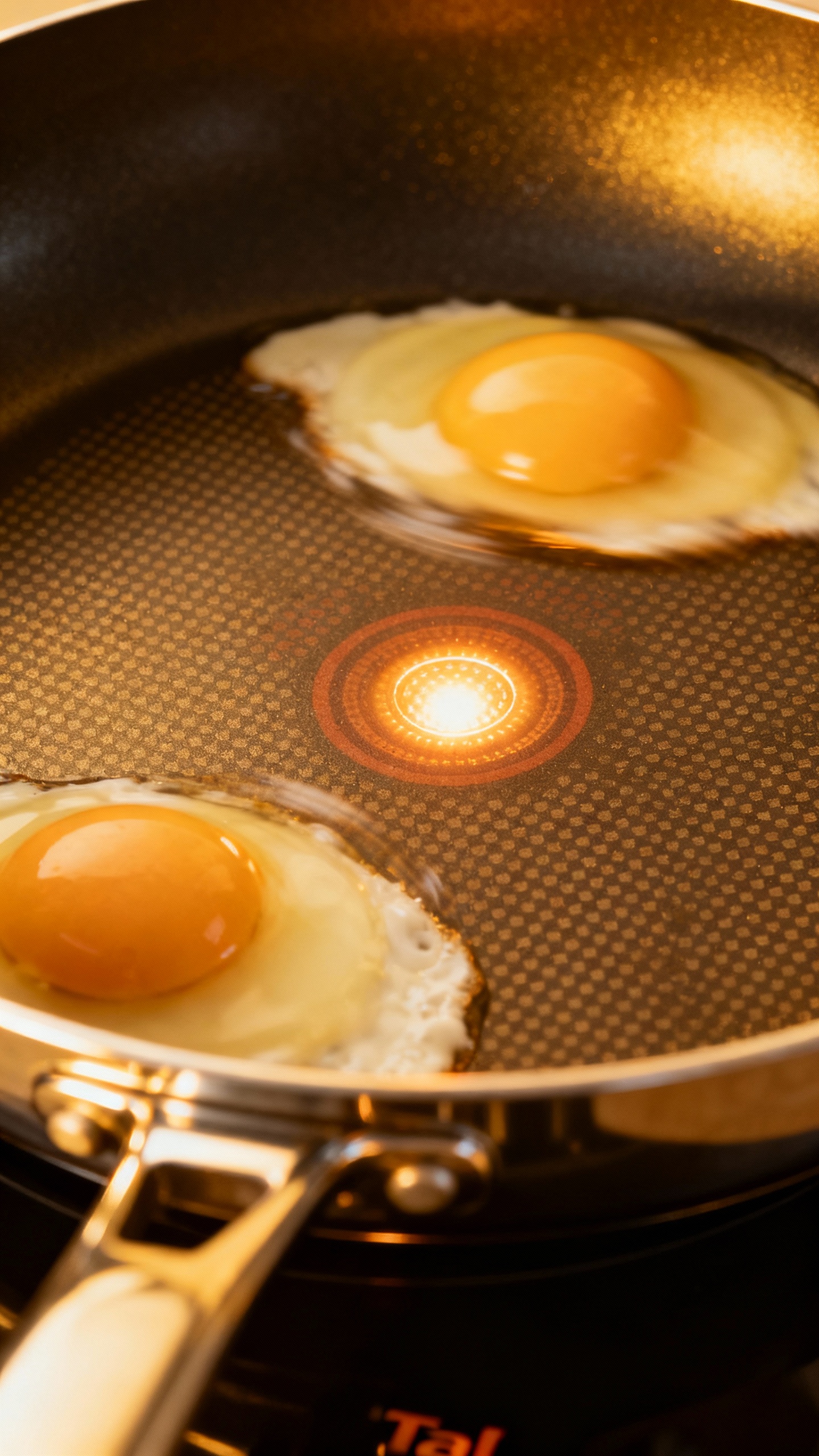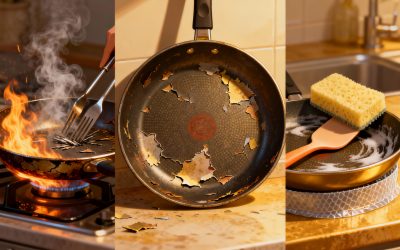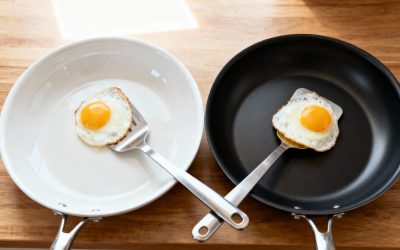You want slick eggs, golden pancakes, and zero stuck-on mess without dropping half your paycheck on cookware. Totally fair. The good news: you can get a solid nonstick set for under $100 that cooks evenly, cleans easily, and doesn’t scream “college dorm.” Let’s talk the real standouts, what to look for, and how to keep your pans from turning into scratched-up frisbees.
What Actually Matters in a Budget Nonstick Set

Before we dive into the winners, let’s cover the must-haves.
You don’t need 14 pieces you’ll never use. You need the right basics and a coating that holds up.
- Core material: Aluminum heats fast and evenly. Hard-anodized aluminum adds durability (big win under $100).
- Coating: PTFE (classic Teflon-style) gives the slipperiest surface.Ceramic nonstick skips PTFE and can feel “grabbier” sooner.
- Lids and handles: Look for tempered glass lids and riveted handles that don’t wiggle after three months.
- Cooktop compatibility: Not all sets work on induction. Check for “induction-ready” or a magnetic base if you need it.
- Oven-safe: Handy for finishing dishes. Under $100 usually means 300–400°F oven-safe, sometimes more.
The 10 Best Nonstick Cookware Sets Under $100
FYI: Prices shift, but these sets routinely land under the $100 mark and hit way above their weight class.
- T-fal Initiatives Nonstick Cookware Set (14-Piece) – The crowd-pleaser.Even heating, Thermo-Spot heat indicator, and durable PTFE that releases like a dream. Not induction-ready, but fantastic for everyday eggs, pancakes, and stir-fries.
- Amazon Basics Nonstick Cookware Set (8–15 Piece Options) – Bare-bones, budget-friendly, and shockingly capable. Lightweight aluminum, PTFE nonstick, and comfy handles.Perfect starter set or spare set for rentals.
- Gotham Steel Pro Hard-Anodized Set (10-Piece) – Often dips under $100 on sale. Hard-anodized base with a ceramic-titanium coating. Slightly less slippery than PTFE but more scratch-resistant.Oven-safe and sturdy.
- GreenLife Soft Grip Ceramic Nonstick Set (12-Piece) – Eco-conscious ceramic coating, PFAS-free, and bright colors that don’t scream “sad beige.” Best for low-to-medium heat cooks who like quick cleanup.
- Tramontina Select Aluminum Nonstick (8–10 Piece) – Known for balanced weight and solid performance. PTFE coating feels premium in this price range. Great everyday set with tempered glass lids.
- Cook N Home Nonstick Pots and Pans Set (12-Piece) – Straightforward, light, and easy.Good heat distribution and comfy handles. If you want a simple set that just works, this is it.
- Farberware Millennium Nonstick Set (10-Piece) – Sturdy feeling, solid nonstick, and a good mix of pans and pots. Handles stay cool, and the finish lasts with a little care.
- Rachael Ray Classic Brights Nonstick Set (10-Piece) – Fun colors, grippy rubberized handles, and a coating that releases like butter.If vibes matter, this one brings personality to the stovetop.
- Cuisinart Advantage Ceramica XT (11-Piece) – Ceramic nonstick with a smoother feel than most. Glass lids, silicone handles, and even heating. Keep it at medium heat and it rewards you.
- Utopia Kitchen Nonstick Set (8-Piece) – Minimalist but reliable.Good for smaller kitchens, first apartments, or anyone who wants the essentials without the fluff.
Sets That Feel “Worth It” IMO
– Best all-around: T-fal Initiatives – Best ceramic: GreenLife Soft Grip – Best durability under $100: Gotham Steel Hard-Anodized – Best value starter: Amazon Basics

What You Actually Need (and What You Don’t)
Don’t get dazzled by 15-piece sets. Half the pieces are plastic spoons and a steamer you’ll never use. You can do 90% of cooking with:
- 10-inch skillet (eggs, sandwiches, searing chicken)
- 12-inch skillet with lid (stir-fries, one-pan meals)
- 2-quart saucepan with lid (rice, sauces, oatmeal)
- 5–6 quart Dutch oven or stockpot (soups, pasta, big batches)
Everything else?
Nice to have. Not mandatory.
Bonus Pieces Worth Having
– Griddle for pancakes and smash burgers – Sauté pan for bigger family meals – Steamer insert if you actually steam veggies (no judgment if you don’t)
PTFE vs. Ceramic: Which Nonstick Is Better?
This debate gets spicy.
Here’s the simple breakdown.
- PTFE (Teflon-style): Ultra-slippery, great for eggs, crepes, and delicate fish. Usually lasts longer if you avoid high heat and metal tools.
- Ceramic: No PTFE or PFOA, and it feels “clean” to use. It can lose slickness faster, especially over high heat.Treat it gently and it’ll stay happy.
So which should you pick? If you love omelets and low-stress cleanup, PTFE wins. If you want a PFAS-free option and cook mostly at medium heat, ceramic feels great.
IMO, both can be excellent if you keep the heat reasonable.

How to Make Your Nonstick Last Longer
Want your sub-$100 set to behave like a $200 set? Treat it right.
- Use medium heat or lower. Nonstick doesn’t need blazing heat.
- No aerosol spray oil. It gums up the surface. Use a tiny bit of butter or regular oil instead.
- Wood, silicone, or nylon tools only. Save the metal for stainless steel pans.
- Hand wash. Even if it says dishwasher-safe, hand washing keeps the coating happier.
- Cool before rinsing. Thermal shock can warp pans and shorten their life.
- Nest with protection. Slip paper towels or pan protectors between stacked pans.
Quick Fix for Stubborn Buildup
If food starts sticking, simmer a mix of water and a few tablespoons of vinegar for a couple minutes, rinse, then wipe with a drop of baking soda.
It helps remove residue that kills nonstick slickness.
Features That Actually Save Time
– Pour spouts + strainer lids: Drain pasta or grease without playing pot-and-lid Tetris. – Glass lids: Peek without losing heat. Little thing, big perk. – Oven-safe handles: Finish frittatas or keep dishes warm. – Induction-ready base: If you’ve got induction, don’t guess. Check the specs or grab a magnet and test the base.
FAQ
Are cheap nonstick sets safe?
Yes, if you use them correctly.
Keep heat at medium or lower, don’t preheat empty pans forever, and avoid aerosol sprays. Modern PTFE coatings are PFOA-free, and ceramic coatings skip PTFE entirely. Use the right tools and you’re good.
Can I use nonstick on high heat?
You can, but you’ll kill the coating faster.
Nonstick shines at medium heat. For searing steaks at ripping-hot temps, use stainless steel or cast iron instead.
Is ceramic better than Teflon-style PTFE?
Different strengths. PTFE usually stays slick longer, which makes life easier for eggs and delicate foods.
Ceramic feels cleaner and avoids PFAS, but it can lose nonstick performance sooner if you crank the heat. Pick based on your cooking style.
What pieces should I prioritize if I’m buying a small set?
Grab a 10–12 inch skillet, a 2-quart saucepan, and a 5–6 quart stockpot. That trio handles breakfasts, sauces, pasta, soups, and most weekday meals.
Do dishwasher-safe sets actually survive the dishwasher?
They survive, but they don’t thrive.
Detergents and hot cycles wear coatings faster. Hand wash in 30 seconds and your pans will last way longer. Worth it, IMO.
How long will a budget nonstick set last?
With good care, 1–3 years of solid performance is realistic.
After that, expect some decline. At this price point, replacement every few years isn’t unusual.
Final Thoughts
You don’t need luxury cookware to nail weeknight dinners. A smart under-$100 nonstick set gets you fast heat, easy cleanup, and zero stress when you flip an omelet.
Pick a set that matches how you cook, keep the heat sane, and don’t let metal utensils near it. Your eggs—and your wallet—will thank you.




0 Comments